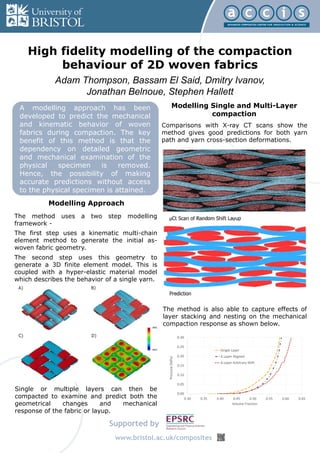ACCIS_ConferencePoster2016_AdamThompson
•Download as PPT, PDF•
0 likes•67 views
Report
Share
Report
Share

Recommended
Recommended
A Review of Some Significant Research Trends in Yarn Texturising by Gokarneshan N* in Crimson Publishers: Peer Reviewed Material Science JournalsA Review of Some Significant Research Trends in Yarn Texturising - Crimson Pu...

A Review of Some Significant Research Trends in Yarn Texturising - Crimson Pu...CrimsonPublishersRDMS
More Related Content
What's hot
What's hot (14)
Textural Feature Extraction and Classification of Mammogram Images using CCCM...

Textural Feature Extraction and Classification of Mammogram Images using CCCM...
A New Approach to the Detection of Mammogram Boundary 

A New Approach to the Detection of Mammogram Boundary
Polymers Characterisation, Polymerisation Techniques & Their Applications

Polymers Characterisation, Polymerisation Techniques & Their Applications
Midsemreview ppt on multiscale modelling using fem

Midsemreview ppt on multiscale modelling using fem
Identification of Material Parameters of Pultruded FRP Composite Plates using...

Identification of Material Parameters of Pultruded FRP Composite Plates using...
Similar to ACCIS_ConferencePoster2016_AdamThompson
A Review of Some Significant Research Trends in Yarn Texturising by Gokarneshan N* in Crimson Publishers: Peer Reviewed Material Science JournalsA Review of Some Significant Research Trends in Yarn Texturising - Crimson Pu...

A Review of Some Significant Research Trends in Yarn Texturising - Crimson Pu...CrimsonPublishersRDMS
Similar to ACCIS_ConferencePoster2016_AdamThompson (20)
A Review of Some Significant Research Trends in Yarn Texturising - Crimson Pu...

A Review of Some Significant Research Trends in Yarn Texturising - Crimson Pu...
Micro Mechanical Modeling of Fiber / Epoxy Unidirectional Laminates Using Fea

Micro Mechanical Modeling of Fiber / Epoxy Unidirectional Laminates Using Fea
Continuum Modeling Techniques to Determine Mechanical Properties of Nanocomp...

Continuum Modeling Techniques to Determine Mechanical Properties of Nanocomp...
Comparative Study of Morphological, Correlation, Hybrid and DCSFPSS based Mor...

Comparative Study of Morphological, Correlation, Hybrid and DCSFPSS based Mor...
Unguided crack growth simulation in asymmetric specimens using bond-based per...

Unguided crack growth simulation in asymmetric specimens using bond-based per...
Hyperelastic material models in finite element analysis of polymers

Hyperelastic material models in finite element analysis of polymers
ANALYSIS OF TENSILE BEHAVIOR HYBRID CARBON - JUTE FIBER RENIFORCED EPOXY COMP...

ANALYSIS OF TENSILE BEHAVIOR HYBRID CARBON - JUTE FIBER RENIFORCED EPOXY COMP...
Effect of machine parameters on knit fabric specifications

Effect of machine parameters on knit fabric specifications
ACCIS_ConferencePoster2016_AdamThompson
- 1. www.bristol.ac.uk/composites A modelling approach has been developed to predict the mechanical and kinematic behavior of woven fabrics during compaction. The key benefit of this method is that the dependency on detailed geometric and mechanical examination of the physical specimen is removed. Hence, the possibility of making accurate predictions without access to the physical specimen is attained. High fidelity modelling of the compaction behaviour of 2D woven fabrics Adam Thompson, Bassam El Said, Dmitry Ivanov, Jonathan Belnoue, Stephen Hallett Modelling Approach The method uses a two step modelling framework - The first step uses a kinematic multi-chain element method to generate the initial as- woven fabric geometry. The second step uses this geometry to generate a 3D finite element model. This is coupled with a hyper-elastic material model which describes the behavior of a single yarn. Modelling Single and Multi-Layer compaction Single or multiple layers can then be compacted to examine and predict both the geometrical changes and mechanical response of the fabric or layup. Comparisons with X-ray CT scans show the method gives good predictions for both yarn path and yarn cross-section deformations. The method is also able to capture effects of layer stacking and nesting on the mechanical compaction response as shown below. 0.00 0.05 0.10 0.15 0.20 0.25 0.30 0.30 0.35 0.40 0.45 0.50 0.55 0.60 0.65 Pressure(MPa) Volume Fraction Single Layer 6 Layer Aligned 6 Layer Arbitrary Shift Supported by
